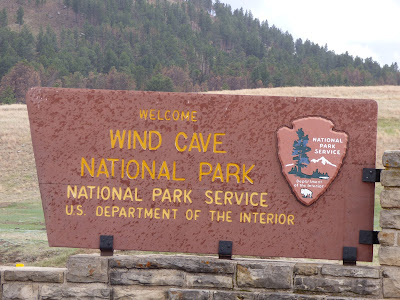 |
| Red Fox (Vulpes vulpes) |
My wild west trip started early on May 6th. When I arrived at my car, their was a fox waiting for me. It watched me from about 10-feet from the car, and jumped back when I started the engine and backed out.
My first day's drive ended in the Twin Cities after a 300-mile drive. I spent a nice night with my parents before heading off early the next morning for the Badlands National Park.
 |
| Storm over the Prairies Near Wall, S.D. |
Most of South Dakota is quite flat, which makes it easier to see the storms coming. Near Wall, South Dakota, I saw several amazing storms crossing the prairie. After a brief stop at the famous Wall Drug Store, I entered the Badlands National Park, and found my way to the Sage Creek Wilderness Campground.
Since there were storms visible all around the campground, I decided to spend that night inside my car. When the storms blew through in the middle of the night, I was glad I had made that decision.
 |
| Wall Drug Store, S.D. |
 |
| Badlands National Park, S.D. |
Then next morning, I was awoken by the serenade of the western
meadowlark. I got out of my car to enjoy the beautiful music, identify
the bird, and get some pictures before climbing back into the car to get
a little more sleep. The campground was beautiful around sunrise.
 |
| Western Meadowlark at the Sage Creek Wilderness Campground, Badlands National Park, S.D. |
|
 |
| Sage Creek Wilderness, Badlands National Park, S.D. at Sunrise |
When I got up again, people were moving around the campground. Much to my delight, prairie dogs were within the campground, and bison were roaming on the outskirts. I enjoyed a quick breakfast and went exploring on foot to see the fascinating geology and wildlife of that beautiful Sage Creek Wilderness campground.
After breaking camp, I took the road tour of the Badlands National Park. The geological formations, and wildlife were spectacular. Some of the wildlife highlights were the prairie dogs, bison, pronghorn, and many great birds.
 |
| Prairie Dog |
 |
| Prairie Dogs |
 |
| Sage Creek Wilderness, Badlands National Park, S.D. |
 |
| Bison in the Badlands National Park, S.D. |
 |
| Pronghorn in Badlands National Park, S.D. |
 |
| Badlands National Park, S.D. |
 |
| Badlands National Park, S.D. |
 |
| Badlands National Park, S.D. |
 |
| Badlands National Park, S.D. |
 |
| Mt. Rushmore, S.D. |
After touring the Badlands National Park for several hours, I drove to Mt. Rushmore. It was fun to see these famous carvings as well as all the state and territorial flags, and read about the history in their visitor's center. On the way out, I stopped at a wayside to get a side view of the presidents, and also caught a distant glimpse of the Crazy Horse Memorial.
 |
| Mt. Rushmore, S.D. |
 |
| Mt. Rushmore, S.D. |
 |
| Wind Cave National Park, S.D. |
The next leg of my journey brought me through Custer State Park to the Wind Cave National Park in time to get on the last cave tour of the day. Wind Cave is the fifth biggest cave in the world, and the third biggest cave in the United States. It is famous for the winds that come out of the natural entrance, the sheer size, and the world's largest collection of boxwork formations. I highly recommend a tour through this unique cave system.
Please note that they are taking good steps to prevent the spread of white-nose syndrome in bats, you cannot enter the cave with any clothing that has been in another cave outside the Black Hills in the last five years. I found this to be true in other National Parks and Monuments out west as well.
 |
| Boxwork Formations in the Wind Cave, S.D. |
 |
| Wind Cave, S.D. |
 |
| Wind Cave, S.D. |
 |
| Custer State Park, S.D. |
After the tour, I took a quick drive around the very scenic Custer State Park, and spent the night in the Elk Mountain Campground of the Wind Cave National Park.
 |
| Bison with Calves in Custer State Park, S.D. |
 |
| Bison Herd in Custer State Park, S.D. |























































